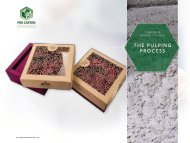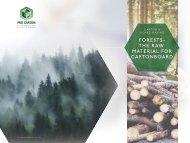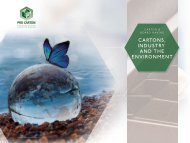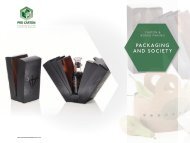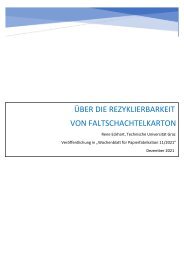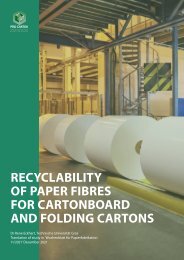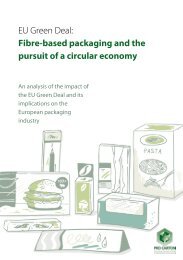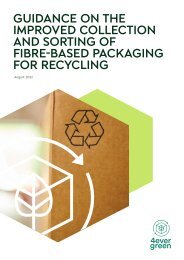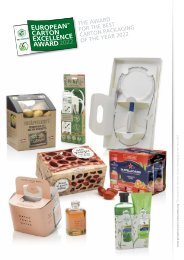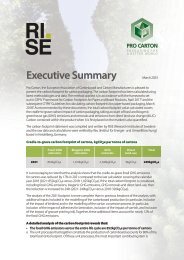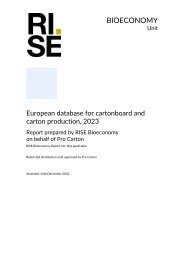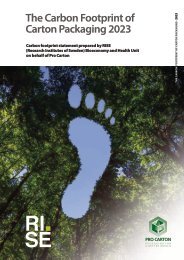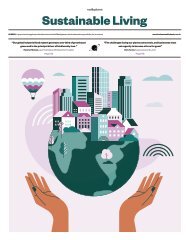You also want an ePaper? Increase the reach of your titles
YUMPU automatically turns print PDFs into web optimized ePapers that Google loves.
1<br />
BIOECONOMY<br />
Unit<br />
<strong>European</strong> <strong>Environmental</strong> <strong>Database</strong> <strong>for</strong><br />
<strong><strong>Carton</strong>board</strong> <strong>and</strong> <strong>Carton</strong> <strong><strong>Pro</strong>duction</strong><br />
Malin Johansson <strong>and</strong> Michael Sturges<br />
RISE Bioeconomy Report No: Not applicable<br />
Restricted distribution: For use only with the permission of <strong>Pro</strong> <strong>Carton</strong><br />
THIS REPORT IS CONFIDENTIAL <strong>and</strong> only <strong>for</strong> use by LCA experts.<br />
<strong>Pro</strong> <strong>Carton</strong><br />
Association of <strong>European</strong> <strong><strong>Carton</strong>board</strong> <strong>and</strong> <strong>Carton</strong> Manufacturers<br />
Todistrasse 47<br />
CH 8027 Zurich<br />
Switzerl<strong>and</strong><br />
www.procarton.com
2<br />
Contents<br />
Contents ..................................................................................................... 2<br />
1 Introduction......................................................................................... 3<br />
2 Description of the production process ................................................. 4<br />
2.1 General description of cartonboard <strong>and</strong> folding cartons .................................. 4<br />
2.2 Types of cartonboard ......................................................................................... 4<br />
2.3 <strong><strong>Carton</strong>board</strong> production .....................................................................................5<br />
2.4 <strong>Carton</strong> production .............................................................................................. 9<br />
3 Description of the <strong>Pro</strong> <strong>Carton</strong> environmental database <strong>for</strong> LCA .......... 11<br />
3.1 Boundaries ........................................................................................................ 12<br />
3.2 Representativeness ........................................................................................... 14<br />
3.3 Data collection .................................................................................................. 15<br />
3.3.1 Questionnaire ............................................................................................ 15<br />
3.3.2 Allocation of inputs <strong>and</strong> outputs ............................................................... 15<br />
3.3.3 Validation .................................................................................................. 15<br />
3.4 Material input <strong>and</strong> output ................................................................................ 15<br />
3.4.1 Raw material .............................................................................................. 15<br />
3.4.2 Chemical inputs ......................................................................................... 16<br />
3.4.3 Material outputs ........................................................................................ 16<br />
3.4.4 Wastes/Residues ....................................................................................... 16<br />
3.5 Energy input <strong>and</strong> output ................................................................................... 16<br />
3.6 Emissions to air ................................................................................................ 17<br />
3.7 Emissions to water ............................................................................................ 18<br />
3.8 Transport .......................................................................................................... 18<br />
4 Data ................................................................................................... 20
3<br />
1 Introduction<br />
<strong>Pro</strong> <strong>Carton</strong>, the <strong>European</strong> Association of <strong><strong>Carton</strong>board</strong> <strong>and</strong> <strong>Carton</strong> Manufacturers is<br />
pleased to present this fifth edition of the <strong>European</strong> <strong>Environmental</strong> <strong>Database</strong> <strong>for</strong><br />
cartonboard <strong>and</strong> carton production. This data is representative of the whole industry<br />
<strong>and</strong> thereby contributes to the growing body of life cycle data in the paper <strong>and</strong> board<br />
packaging sector.<br />
The aim of this database is to provide life cycle experts with the best possible<br />
environmental data from the industry in order that their analysis <strong>and</strong> studies will be as<br />
up-to-date <strong>and</strong> accurate as possible.<br />
Technical experts in cartonboard <strong>and</strong> carton manufacturing processes have worked<br />
together with LCI experts to provide a database which is based on both technological<br />
knowledge of cartonboard <strong>and</strong> carton production <strong>and</strong> LCI study requirements.<br />
This database contains in<strong>for</strong>mation on the inputs <strong>and</strong> outputs of the total <strong>European</strong><br />
cartonboard <strong>and</strong> carton industry to the environment, measuring a range of emissions<br />
<strong>and</strong> reporting weighted averages. The database should not be regarded as a benchmark<br />
<strong>for</strong> the industry, or as a tool <strong>for</strong> comparisons between different parts of the industry. If<br />
specific in<strong>for</strong>mation on a particular cartonboard grade is required, then this should be<br />
requested directly from the manufacturers.<br />
<strong>Pro</strong> <strong>Carton</strong> is grateful to its member companies <strong>for</strong> their willing co-operation in its<br />
compilation. It is anticipated that further updates will be issued on a regular basis.<br />
This report has been prepared by RISE (Research Institutes of Sweden) on behalf of <strong>Pro</strong><br />
<strong>Carton</strong> <strong>and</strong> the report <strong>and</strong> data has been subjected to external peer review by ifeu –<br />
Institute <strong>for</strong> Energy <strong>and</strong> <strong>Environmental</strong> Research Heidelberg GmbH, Germany.<br />
For further in<strong>for</strong>mation, please contact:<br />
Tony Hitchin<br />
General Manager<br />
<strong>Pro</strong> <strong>Carton</strong><br />
hitchin@procarton.com<br />
August <strong>2019</strong>
4<br />
2 Description of the production<br />
process<br />
2.1 General description of cartonboard <strong>and</strong><br />
folding cartons<br />
Folding cartons are small to medium sized “cardboard boxes” made from cartonboard.<br />
They are used to package a wide range of products from foodstuffs – such as cereals,<br />
frozen <strong>and</strong> chilled food, confectionery, bakery goods, tea, coffee <strong>and</strong> other dry foods – to<br />
pharmaceuticals, medical <strong>and</strong> healthcare products, perfumes, cosmetics, toiletries,<br />
photographic products, clothing, cigarettes, toys, games, household <strong>and</strong> electrical,<br />
engineering, gardening <strong>and</strong> DIY (do-it-yourself) products.<br />
There are many different types of cartonboard manufactured, all of which can be made<br />
in a variety of different weights (grammages) <strong>and</strong> thicknesses. The type of cartonboard<br />
<strong>and</strong> the fibre composition depends on the intended use <strong>and</strong> the specific requirements.<br />
Usually paperboard is made up of several plies to make the best possible use of the<br />
different types of raw materials <strong>and</strong> optimise the product per<strong>for</strong>mance.<br />
<strong><strong>Carton</strong>board</strong> is made from cellulose containing fibres that are produced either from wood<br />
or from recovered paper <strong>and</strong> board. A combination of the two can be used <strong>and</strong> there are<br />
various types of fibre that produce different characteristics. For example, shorter fibres<br />
generally give a better bulk <strong>and</strong> longer fibres give a greater stiffness <strong>and</strong> so types of fibre<br />
are mixed to produce the desired characteristics.<br />
The fibres can also be treated with various chemicals to improve a variety of properties<br />
such as moisture <strong>and</strong> grease barriers. Additionally, they can be coated with a range of<br />
barriers to produce cartonboard that can be used in ovens <strong>and</strong> microwaves <strong>and</strong> other<br />
specialist packaging. They can also have metal effects added to them to enhance the<br />
appearance of the finished product.<br />
2.2 Types of cartonboard<br />
Solid Bleached Board SBB, (also known as SBS / GZ)<br />
This grade is typically made from pure bleached chemical pulp with two or three layers<br />
of coating on the top surface <strong>and</strong> one or more layers on the reverse. There are also<br />
uncoated grades. Typical markets include cosmetics, pharmaceuticals, graphics, tobacco<br />
<strong>and</strong> luxury packaging.<br />
Solid Unbleached Board SUB (also known as SUB / SUS)<br />
This grade is typically made from pure unbleached chemical pulp with two or three layers<br />
of coating on the top surface. In some cases, a white reverse surface is applied. It is<br />
primarily used as beverage carriers <strong>for</strong> bottles <strong>and</strong> cans, as it is very strong <strong>and</strong> can be<br />
made resistant to water. It is used where strength of packaging is important. SUB may
5<br />
also be used in the production of liquid beverage cartons <strong>and</strong> liquid food cartons, but this<br />
application is excluded from the scope of the data collected in this report.<br />
Folding Boxboard FBB (also known as GC /UC)<br />
This grade is typically made of mechanical pulp s<strong>and</strong>wiched between two layers of<br />
chemical pulp with up to three layers of coating on the top or printing surface <strong>and</strong> one<br />
layer of coating on the reverse. Typical uses include pharmaceuticals, confectionery,<br />
frozen <strong>and</strong> chilled foods.<br />
White Lined Chipboard WLC (also known as GT /GD /UD)<br />
This grade is typically made using predominantly recovered paper or recovered fibres. It<br />
is manufactured in a number of layers, each of which use selected grades of raw<br />
materials. It typically has up to three layers of coating on the top or printing surface <strong>and</strong><br />
one layer on the reverse. It is used in a range of applications such as frozen <strong>and</strong> chilled<br />
foods, cereals, shoes, tissues <strong>and</strong> toys.<br />
The make-up of the total production in Europe is currently as follows SBB/SBS 9.3%;<br />
FBB 39.3%; WLC 51.4% (excluding production of board <strong>for</strong> liquid beverage<br />
cartons/liquid food cartons).<br />
The average consumption of cartonboard in Europe is approximately 10 kgs per person<br />
per year.<br />
More in<strong>for</strong>mation <strong>and</strong> statistics can be found at the <strong>Pro</strong> <strong>Carton</strong> website<br />
www.procarton.com.<br />
2.3 <strong><strong>Carton</strong>board</strong> production<br />
In Europe, responsible sourcing of raw material <strong>for</strong> cartonboard which is used <strong>for</strong> the<br />
production of folding cartons, is from both wood <strong>and</strong> recovered paper.<br />
The wood raw material comes from sustainably managed <strong>for</strong>ests. Not only are they a<br />
renewable resource, but in Europe <strong>for</strong>est growth exceeds wood harvested. <strong>European</strong><br />
<strong>for</strong>ests are grown <strong>and</strong> harvested in a carefully controlled <strong>and</strong> sustainable way – so<br />
successfully that <strong>European</strong> <strong>for</strong>ests, where most of the raw material comes from, have<br />
grown by an area the size of Switzerl<strong>and</strong> in just 10 years 1 .<br />
To achieve this, <strong>European</strong> <strong>for</strong>ests owners <strong>and</strong> operators follow a combination of national,<br />
<strong>European</strong> <strong>and</strong> international <strong>for</strong>est laws <strong>and</strong> regulations. They can prove <strong>for</strong>ests are<br />
managed through Forest Certification Schemes such as FSC ® <strong>and</strong> PEFC. A “chain of<br />
custody” certificate demonstrates that the wood used to make cartonboard in Europe<br />
originates from legal <strong>and</strong> traceable sources.<br />
1<br />
https://www.twosides.info/european-<strong>for</strong>ests/
6<br />
Trees also remove <strong>and</strong> store carbon from the atmosphere. According to the <strong>European</strong><br />
GHG inventory, <strong>for</strong>ests of the EU-28 are a net carbon sink, with net CO2 removals by<br />
<strong>for</strong>ests having increased by over 19% between 1990 <strong>and</strong> 2014. 2<br />
Wood is processed with chemical or mechanical pulping processes to make the wood<br />
fibres suitable <strong>for</strong> the paperboard making.<br />
Wood contains about 50% water. The dry biomass comprises cellulose, hemicelluloses<br />
<strong>and</strong> lignin, a hard, brittle material that binds fibres together <strong>and</strong> small amounts of wood<br />
resins.<br />
In mechanical pulping, the fibres are separated by applying mechanical <strong>for</strong>ce to either<br />
debarked logs (roundwood) or smaller chips (refiner mechanical). The heat generated<br />
softens the lignin <strong>and</strong> results in fibre separation. The pulp is then screened <strong>and</strong> cleaned<br />
<strong>and</strong> any remaining fibre clumps are reprocessed.<br />
In chemical pulping, debarked logs are chipped <strong>and</strong> treated with chemicals under heat<br />
<strong>and</strong> pressure. This dissolves the lignin <strong>and</strong> hemicelluloses of the wood <strong>and</strong> cellulose<br />
fibres can be separated from the cooking liquor. There is a choice of chemicals <strong>for</strong><br />
processing. The kraft or sulphate process is by far the more widely used because of its<br />
ability to process all commonly used types of wood <strong>and</strong> its high rate of chemical recovery.<br />
An alternative raw material source is recovered paper <strong>and</strong> board. Fibre separation is<br />
achieved by mechanical agitation in water.<br />
Recovered paper <strong>and</strong> cartonboard has been printed, sometimes varnished <strong>and</strong> <strong>for</strong><br />
packaging applications, often has been glued. In products where high purity <strong>and</strong><br />
whiteness is important, it is necessary to remove the printing inks, glues <strong>and</strong> other<br />
impurities.<br />
After the recovered paper <strong>and</strong> board has been immersed in water, disintegrated <strong>and</strong> the<br />
fibres dispersed, heat <strong>and</strong>/or dispersion agents are used to remove the often sticky<br />
impurities from the fibre surfaces. Then flotation techniques, screening <strong>and</strong> washing,<br />
sometimes additional bleaching is used to remove any impurities.<br />
Energy sources depend on the way pulp is made <strong>and</strong> the location of the mill. Chemical<br />
pulping results in a by-product which can be used as an energy source itself <strong>for</strong> pulping<br />
<strong>and</strong> where, appropriate, bleaching. In integrated mills the wood by-products also provide<br />
energy, electricity <strong>and</strong> steam <strong>for</strong> the manufacturing process. These energy sources are<br />
there<strong>for</strong>e naturally renewable.<br />
Mechanical pulping <strong>and</strong> fibre recycling uses energy to separate the fibres. This energy<br />
may be made on-site or supplied from external sources. For on-site generation, several<br />
mills have installed combined heat power (CHP) plants which are very efficient<br />
compared to power stations supplying a national grid.<br />
Water is an essential element <strong>for</strong> paper <strong>and</strong> board production. Water acts as a bond<br />
between the fibres <strong>and</strong> in the production process, is needed <strong>for</strong> transporting, cleaning,<br />
as a solvent, carrying energy in the <strong>for</strong>m of steam <strong>and</strong> is used in cooling process units.<br />
Water is usually taken from a nearby surface source such as a lake or river. 95% of the<br />
water used in the industry is cleaned <strong>and</strong> reused on site. All wastewater is purified at the<br />
2<br />
From Guidelines <strong>for</strong> calculating carbon footprints <strong>for</strong> paper-based packaging, CITPA, March 2017
7<br />
mill in accordance with <strong>European</strong> regulations <strong>and</strong> st<strong>and</strong>ards, be<strong>for</strong>e being returned to<br />
the environment.<br />
The cartonboard types included in the study are:<br />
Solid Bleached Board, SBB, made from wood, 100% bleached chemical pulps.<br />
Solid Unbleached Board, SBB, made from wood, 100% unbleached chemical pulps.<br />
Folding Box Board, FBB, made from wood, mainly mechanical pulp <strong>and</strong> some<br />
chemical pulp<br />
White Lined Chipboard, WLC, made from mainly recovered paper <strong>and</strong> board <strong>and</strong><br />
some chemical pulp<br />
The manufacturing process itself <strong>for</strong> all types of cartonboard is fairly similar. This<br />
diagram shows an overview of how cartonboard is manufactured.<br />
Figure 1<br />
Underst<strong>and</strong>ing the manufacturing process<br />
Pulp <strong>and</strong> recovered fibre is mixed with water. It is then cleaned <strong>and</strong> refined <strong>and</strong> pumped to<br />
the cartonboard machine.<br />
A very dilute mixture of fibre <strong>and</strong> water is put onto the machine. As the water drains, a sheet<br />
is <strong>for</strong>med. This is then pressed to extract water <strong>and</strong> passed over steam heated cylinders to<br />
evaporate water. Finally, the board is coated with up to 4 layers of coating <strong>and</strong> wound into<br />
large reels.<br />
The large reels <strong>for</strong> the cartonboard machine are sent to the finishing department where they<br />
are cut either into smaller reels or into sheets <strong>and</strong> packed onto pallets <strong>for</strong> sale <strong>and</strong> distribution.<br />
The fibre, either in the <strong>for</strong>m of pulp made from <strong>for</strong>est thinnings <strong>and</strong> sawmill residues or<br />
recovered paper, is mixed with water in large hydropulpers until a very fine suspension<br />
is achieved. This is then cleaned to remove any contraries, refined to enhance strength<br />
<strong>and</strong> then pumped to the cartonboard machine where the cartonboard is manufactured.<br />
In the fibre preparation be<strong>for</strong>e the board making functional additives are used. The<br />
additives provide some degree of water resistance (hydrophobicity) <strong>and</strong> add internal <strong>and</strong><br />
surface strength to the product.
8<br />
The dispersed fibres with the functional additives <strong>and</strong> water mixture from the<br />
preparation plant, is pumped to the cartonboard machine <strong>and</strong> this very thin mixture,<br />
9<br />
The manufacture of Folding Box Board, FBB, is also to a large degree integrated but<br />
usually the required chemical pulp is purchased. The mechanical processing of wood<br />
requires electricity. Bark, wood residues <strong>and</strong> heat recovery from the pulping process are<br />
used <strong>for</strong> process steam <strong>and</strong> heat.<br />
Due to the high degree of integration these types of mills can utilise wood residues as a<br />
biofuel covering a significant part of the energy consumption. The fact that these mills<br />
have their own pulping processes means that energy <strong>and</strong> water are consumed in addition<br />
to the needs from the cartonboard making process.<br />
White Lined Chipboard, WLC, is typically made in non-integrated processes<br />
meaning that all the main raw materials (i.e. recovered paper, chemical pulps etc.) are<br />
purchased <strong>and</strong> then prepared be<strong>for</strong>e the board making process. In comparison to<br />
integrated manufacture this requires less energy <strong>and</strong> water (no pulping processes).<br />
Usually there are no options <strong>for</strong> biofuels, which means that natural gas <strong>and</strong> electricity<br />
are the main energy source.<br />
2.4 <strong>Carton</strong> production<br />
Folding cartons are very versatile <strong>and</strong> can be designed in a wide variety of ways. For a<br />
variety of examples, please visit www.procarton.com<br />
<strong>Carton</strong> production starts with the cartonboard delivered from the mills.<br />
Below is a diagram showing a typical layout of a carton production plant.<br />
Figure 2<br />
Typical layout of a carton production plant
10<br />
The design <strong>for</strong> a carton is either sent to the carton producer or developed by them. The<br />
graphics are prepared on a computer <strong>and</strong> colour separation is carried out. From this a<br />
printing plate <strong>for</strong> each colour is prepared. At the same time a “lay out” is designed.<br />
The cartonboard in either sheets or reels, is loaded into the printing machine <strong>and</strong> printed<br />
in one pass with each colour being added in turn. A variety of printing processes may be<br />
used, including <strong>for</strong> example lithographic, flexographic <strong>and</strong> gravure processes. In some<br />
cases, digital printing may also be used. This is an emerging technology that is expected<br />
to become more important <strong>for</strong> carton production in the future.<br />
Many cartons can be printed on each sheet of cartonboard <strong>and</strong> so a layout is worked out<br />
to ensure that as little cartonboard as possible is left unused. This layout is also used to<br />
prepare the cutting <strong>and</strong> creasing <strong>for</strong>ms that are used later in the production process.<br />
Most cartons are printed using six colours at a time but less or more can also be used. As<br />
well as the colours, a varnish to improve gloss, or to add a highlight, is also usually<br />
printed after the colours.<br />
At the end of the print machine, the sheets are stacked up <strong>and</strong> moved to the next stage of<br />
production – cutting <strong>and</strong> creasing. The printed sheets of cartons are taken to a machine<br />
that cuts the cartons <strong>and</strong> also puts in the creases that enable it to be folded in a later<br />
operation. This is done using a <strong>for</strong>m into which are set knives <strong>and</strong> creasing rules to<br />
achieve the desired result. It is also possible to add embossing during this operation.<br />
Here again, accuracy is critical to ensure the cuts <strong>and</strong> creases are in exactly the right<br />
position.<br />
The individual cartons are then stacked up <strong>and</strong> passed through to the next stage of<br />
production, folding <strong>and</strong> gluing.<br />
When the cartons have been cut <strong>and</strong> creased, they are moved through to the gluing line<br />
where the cartons are folded <strong>and</strong> glued. This is done on high speed machines that, in one<br />
operation, fold the creases <strong>and</strong> glue the seams where necessary.<br />
The cartons are then packed <strong>for</strong> shipment to the carton user who puts them onto their<br />
packing line <strong>for</strong> filling.
11<br />
3 Description of the <strong>Pro</strong> <strong>Carton</strong><br />
environmental database <strong>for</strong> LCA<br />
Life Cycle Assessment (LCA) is a tool <strong>for</strong> the systematic evaluation of the environmental<br />
aspects of a product or service system through all stages of its life cycle. LCA provides an<br />
adequate instrument <strong>for</strong> environmental decision support. Reliable LCA per<strong>for</strong>mance is<br />
crucial to achieve a life-cycle economy. The International Organisation <strong>for</strong><br />
St<strong>and</strong>ardisation (ISO), a world-wide federation of national st<strong>and</strong>ards bodies, has<br />
st<strong>and</strong>ardised this framework within the series ISO 14040 on LCA.<br />
Figure 3<br />
LCA methodology<br />
Goal <strong>and</strong><br />
scope<br />
definition<br />
Inventory<br />
analysis<br />
Interpretation<br />
Impact<br />
assessment<br />
Source: ISO 14040 3 /ISO14044 4<br />
1. Goal <strong>and</strong> Scope Definition, the product(s) or service(s) to be assessed are defined, a<br />
functional basis <strong>for</strong> comparison is chosen <strong>and</strong> the required level of detail is defined;<br />
2. Inventory Analysis of extractions <strong>and</strong> emissions, the energy <strong>and</strong> raw materials used,<br />
<strong>and</strong> emissions to the atmosphere, water <strong>and</strong> l<strong>and</strong>, are quantified <strong>for</strong> each process, then<br />
combined in the process flow chart <strong>and</strong> related to the functional basis;<br />
3. Impact Assessment, the effects of the resource use <strong>and</strong> emissions generated are<br />
grouped <strong>and</strong> quantified into a limited number of impact categories which may then be<br />
weighted <strong>for</strong> importance;<br />
3<br />
ISO 14040:2006 <strong>Environmental</strong> management -- Life cycle assessment -- Principles <strong>and</strong> framework<br />
4<br />
ISO 14040:2006 <strong>Environmental</strong> management -- Life cycle assessment -- Requirements <strong>and</strong> st<strong>and</strong>ard
12<br />
4. Interpretation, the results are reported in the most in<strong>for</strong>mative way possible <strong>and</strong> the<br />
need <strong>and</strong> opportunities to reduce the impact of the product(s) or service(s) on the<br />
environment are systematically evaluated.<br />
<strong>Pro</strong> <strong>Carton</strong> collected the following inputs <strong>and</strong> outputs from the production processes:<br />
<br />
<br />
<br />
<br />
Material inputs <strong>and</strong> outputs<br />
Energy inputs <strong>and</strong> outputs<br />
Emissions to air, water <strong>and</strong> soil<br />
Transport of raw materials<br />
This report gives average inventory data of the partial life cycle. The data provide a basis<br />
to assess the potential environmental impacts of the use of paperboard in the life cycle -<br />
production phase, distribution, use <strong>and</strong> final disposal - of products. Data from upstream<br />
<strong>and</strong> downstream operations as well as entire impact assessment would be needed be<strong>for</strong>e<br />
environmental impacts could be assessed <strong>for</strong> the full life cycle.<br />
3.1 Boundaries<br />
This report includes detail on binders, functional additives, production of purchased heat<br />
<strong>and</strong> cartonboard waste from the converting process. The overall cut-off criterion <strong>for</strong> total<br />
material inputs is 0.05% of the sold product (in total < 0.5 kg per tonne sold product).<br />
The data in chapter 4 are gate-to-gate data, as shown in the diagram below: inputs <strong>and</strong><br />
outputs from the production sites (i.e. cartonboard production <strong>and</strong> carton converting<br />
processes). These data provide the basic in<strong>for</strong>mation needed to compile cradle-to-gate<br />
<strong>and</strong>/or cradle-to-grave Life Cycle Inventories (LCI) 5 . Impacts associated with upstream<br />
<strong>and</strong> downstream processes are not included in the inventory data.<br />
Figure 4<br />
Underst<strong>and</strong>ing different system boundaries<br />
The diagram below provides a detailed overview of the unit processes considered within<br />
the datasets. Data is not provided broken down according to the individual unit<br />
processes. Rather, the in<strong>for</strong>mation is presented as a single black box covering both<br />
production of the cartonboard <strong>and</strong> carton converting processes.<br />
5<br />
Cradle-to-gate LCIs include inputs <strong>and</strong> outputs from upstream processes <strong>and</strong> gate-to-gate processes,<br />
cradle-to-grave LCIs include also the inputs <strong>and</strong> outputs from downstream processes
13<br />
Figure 5<br />
Unit processes included in the analysis
14<br />
Subsequently, the dataset represents the <strong>European</strong> averages <strong>for</strong> the board production,<br />
including typical data <strong>for</strong> the converting <strong>and</strong> printing of the paperboard. Data <strong>for</strong> carton<br />
converting processes was provided by the members of ECMA (<strong>European</strong> <strong>Carton</strong> Makers<br />
Association). 6<br />
In<strong>for</strong>mation about transport can be found in chapter 3.8. The emissions from transport<br />
are not included in the data in chapter 4, but can be calculated by the user based on the<br />
distances reported <strong>and</strong> the application of st<strong>and</strong>ard carbon factors <strong>for</strong> the various modes<br />
of transport detailed.<br />
3.2 Representativeness<br />
The data collected <strong>for</strong> the paperboard production represent 69% (> 5,000,000 tonnes)<br />
of the <strong>European</strong> production capacity of paperboard. Participating mills are located in<br />
Austria, Germany, Finl<strong>and</strong>, Italy, Netherl<strong>and</strong>s, Slovenia, Sweden <strong>and</strong> the UK. The annual<br />
production of the production sites varies from 60,000 – 520,000 tonnes net saleable<br />
product.<br />
The data thus represent the average <strong>European</strong> technology <strong>for</strong> 2017.<br />
The data collected <strong>for</strong> each grade cover:<br />
<br />
<br />
<br />
99% of the production <strong>for</strong> SBB/SUB<br />
71% of the production <strong>for</strong> FBB<br />
52% of the production <strong>for</strong> WLC.<br />
<strong>Pro</strong> <strong>Carton</strong>’s aim was to develop one dataset <strong>for</strong> paperboard. Participating mills agreed<br />
to the following procedure <strong>for</strong> calculating such a dataset:<br />
<br />
<br />
From the response through the questionnaires the consultant calculated separate<br />
datasets representing the weighted averages <strong>for</strong> SBB (solid bleached board), SUB<br />
(solid unbleached board), FBB (folding box board) <strong>and</strong> WLC (white lined<br />
chipboard).<br />
Of the total <strong>European</strong> paperboard production <strong>for</strong> these grades, 9.3% is SBB/SUB,<br />
39.3% is FBB <strong>and</strong> 51.4% is WLC. These percentages have been used to calculate the<br />
averages reported in chapter 4.<br />
<br />
The data in chapter 4 represent the sum of<br />
o 9.3% of the inputs <strong>and</strong> outputs of SBB/SUB,<br />
o 39.3% of those of FBB <strong>and</strong><br />
o 51.4% of those of WLC.<br />
6<br />
More in<strong>for</strong>mation about ECMA can be found at www.ecma.org
15<br />
3.3 Data collection<br />
3.3.1 Questionnaire<br />
The questionnaire was developed from the <strong>Pro</strong> <strong>Carton</strong> questionnaire that was used in <strong>for</strong><br />
data collection in 2015.<br />
The questionnaire looks at the production sites as a black box, requesting in<strong>for</strong>mation<br />
about annual inputs <strong>and</strong> outputs. Internal data on energy production <strong>and</strong> consumption<br />
were asked, but only used <strong>for</strong> checking the consistency of the submitted energy<br />
in<strong>for</strong>mation. These internal flows are not reported in chapter 4.<br />
3.3.2 Allocation of inputs <strong>and</strong> outputs<br />
Most of the mills produce only one grade of product: SBB, SUB, FBB or WLC. There<strong>for</strong>e,<br />
allocation of inputs <strong>and</strong> outputs to different products was needed only in exceptional<br />
cases where a mill produces more than one grade of paper.<br />
<br />
<br />
<br />
Mills provided in<strong>for</strong>mation on the allocation of inputs of raw materials to coproducts<br />
based on consumption in the different production processes.<br />
Causality is difficult <strong>for</strong> other inputs <strong>and</strong> outputs. There<strong>for</strong>e, these were allocated<br />
to the co-products based on mass of production.<br />
In case the mill produces other products (e.g. market pulp, sold energy), the mills<br />
reported only the inputs <strong>and</strong> outputs that were allocated to the cartonboard<br />
production.<br />
The allocation that was applied reflects the underlying physical relationships<br />
between the processes. For this purpose a spreadsheet was developed to help<br />
calculate the data that were then introduced in the questionnaire <strong>for</strong> the cartonboard<br />
production.<br />
No allocation was made to by-products, so the reported inputs <strong>and</strong> outputs include the<br />
production of these by-products.<br />
3.3.3 Validation<br />
A rough check <strong>for</strong> C-balance, energy, water <strong>and</strong> mass balances was included in the<br />
questionnaire.<br />
3.4 Material input <strong>and</strong> output<br />
3.4.1 Raw material<br />
Both primary fibres <strong>and</strong> recycled fibres are used <strong>for</strong> the production of paperboard.<br />
The wood input is reported as dry weight. It originates from final fellings, thinnings <strong>and</strong><br />
sawmill residues. Almost 70% of the roundwood consumed <strong>for</strong> the cartonboard produced<br />
by the participating mills is Chain of Custody certified under a <strong>for</strong>est management<br />
system, FSC ® <strong>and</strong>/or PEFC .
16<br />
Non-integrated mills buy mechanical, chemical <strong>and</strong> de-inked pulp <strong>and</strong> recovered paper.<br />
The pulp data are reported in bone dry 7 weight, which is normally 90% of the wet (air<br />
dry) weight.<br />
WLC is produced mainly from recovered fibres. The recovered paper is reported as total<br />
bone dry weight including other materials (s<strong>and</strong>, metal, plastics, wood). In <strong>European</strong><br />
countries the water content of recovered paper is generally assumed to be about 10%.<br />
The content of other materials in the recovered paper varies between 2%-5%, on average<br />
it is 3%. It is estimated that about a third is due to rejected materials that were associated<br />
with the previous use of the recovered paper (<strong>for</strong> example, staples, paper clips, tags,<br />
adhesive labels, unrecovered fibres etc). The remaining two thirds is material that is not<br />
in any way associated with the previous use of the paper (<strong>for</strong> example, <strong>for</strong>eign items such<br />
as textiles, plastic packaging, glass, s<strong>and</strong>, grit etc).<br />
Coating pigments (Calcium carbonate <strong>and</strong> clay) <strong>and</strong> binders make up <strong>for</strong> about 12% of<br />
the sold paperboard.<br />
3.4.2 Chemical inputs<br />
The mills were asked to report the main additives. These were listed in the questionnaire.<br />
The amounts are reported in bone dry weight.<br />
3.4.3 Material outputs<br />
The main output is paperboard. The average dry content is 92.3% (with a range of 92%-<br />
94%). The main sold by products from the production of paperboard are pine oil <strong>and</strong><br />
bark.<br />
3.4.4 Wastes/Residues<br />
The waste/residues are reported as dry weight. The EWC (<strong>European</strong> Waste Catalogue)<br />
numbers have been used as far as possible to identify the different solid wastes/residues.<br />
3.5 Energy input <strong>and</strong> output<br />
Fuel inputs to the sites have been reported in GJ. The lower calorific values have been<br />
used to calculate GJ from m3 or tonnes of fuel. Fossil fuel <strong>and</strong> biomass fuel have been<br />
reported separately.<br />
Input of electricity <strong>and</strong> steam to the sites is also reported. The electricity <strong>and</strong> steam that<br />
is produced at the site itself is not reported. Some mills are selling energy externally in<br />
the <strong>for</strong>m of electricity, steam or heat. In the inventory these are not reported as sold<br />
products <strong>and</strong> their input <strong>and</strong> output data is not included in the inventory results.<br />
The reported voltage of the purchased electricity is medium (1-24Kv) or high (>24kV)<br />
voltage. The electricity is not always purchased from the grid: it is partly purchased from<br />
external energy services with e.g. natural gas as fuel.<br />
7<br />
Bone dry weight: weight without any water
17<br />
The production sites are treated as a black box, giving data on inputs <strong>and</strong> outputs only.<br />
For fully integrated mills with chemical pulping, energy is recovered in this box through<br />
burning of black liquor, wood residues <strong>and</strong> bark from wood coming in at production sites.<br />
Additional use of fossil fuels is avoided by using these mill-born biofuels.<br />
3.6 Emissions to air<br />
Emissions from external fuel combustion (e.g. transport, electricity generation <strong>for</strong> the<br />
public grid) are not included in the data.<br />
The emissions of particles, NOx, SOx <strong>and</strong> CO arising at the mill are based on<br />
measurements. Particle size was not specified.<br />
The CO2 figures are calculated <strong>for</strong> fossil fuel origin, using the IPCC 2006 8 . Methane <strong>and</strong><br />
nitrous oxide hardly contribute (less than 0.5 %) to the CO2-equivalents <strong>for</strong> these fuels.<br />
kg CO2/GJ<br />
Natural gas 56<br />
Heavy fuel oil 77<br />
Light fuel oil 74<br />
Diesel oil 74<br />
Hard coal 95<br />
Peat 106<br />
The calculation of CO2 from wood-based fuels is more problematic.<br />
The moisture content may vary from 20% (black liquor) to 70% (sludges) <strong>and</strong> it affects<br />
the net heat value. The corresponding CO2-factor <strong>for</strong> fuels expressed as their net heat<br />
value varies between 106 <strong>and</strong> 150 kg CO2/GJ.<br />
The factor 126 kg CO2/GJ of wood-based fuel has been used to calculate the biomassbased<br />
CO2 emissions in case the real emissions were unknown.<br />
Normally in LCA, the CO2 originating from biomass are not considered to contribute to<br />
GWP (global warming potential). This is due to the fact that the releases of CO2 are<br />
compensated <strong>for</strong> by the CO2 that has been taken up out of the atmosphere during the<br />
growth of the biomass.<br />
In principle, peat is a bioenergy, but <strong>for</strong> LCA purposes it is regarded as a fossil fuel.<br />
There<strong>for</strong>e, the CO2 emissions from peat are reported as CO2 from fossil fuel.<br />
8<br />
2006 IPCC Guidelines <strong>for</strong> National Greenhouse Gas Inventories, http://www.ipccnggip.iges.or.jp/public/2006gl/index.html.
18<br />
3.7 Emissions to water<br />
When paperboard mills use surface water, they do not consume this water during the<br />
production process. After (re)use it is returned to the rivers or seas as cooling water <strong>and</strong><br />
purified effluent water. A limited amount of water is evaporated in the drying section of<br />
the paperboard production.<br />
All mills have some sort of effluent water treatment: mechanical, chemical <strong>and</strong> biological<br />
aerobic treatment <strong>and</strong> in some cases also anaerobic treatment of the effluent.<br />
A few mills send their effluent to external wastewater treatment plants. The emissions<br />
from the mills with partly external wastewater treatment are not included in the averages<br />
that are reported.<br />
Most of the mills with their own wastewater treatment measure all of the parameters <strong>for</strong><br />
substances in process water included in the inventory. For mills where data points were<br />
not available <strong>for</strong> certain parameters, their production was excluded from the calculation<br />
of the weighted average emissions of this parameter.<br />
3.8 Transport<br />
The transport distances of wood raw materials from the harvesting sites in the <strong>for</strong>ests to<br />
the mills have been reported separately <strong>for</strong> trucks, rail <strong>and</strong> ships. The trucks <strong>and</strong> rail<br />
wagons are normally loaded to full capacity but go back empty. The trucks carry 40-44<br />
tonnes of wood. This in<strong>for</strong>mation has been collected on a species-species basis <strong>for</strong> each<br />
mill, considering the wet weight of the wood. Distances <strong>and</strong> tonnages of wood delivered<br />
have then been used to calculate the total t.km <strong>for</strong> delivery of wood by each mode of<br />
transport (truck, rail <strong>and</strong> boat). This is then used to calculate the t.km/t of production<br />
<strong>for</strong> each grade (WLC, FBB, <strong>and</strong> SBB/SUB) at each mill. This is calculated on a mill-bymill,<br />
input-by-input basis. A weighted average t.km is then calculated based on the<br />
relative production share of each mill.<br />
A similar approach is applied <strong>for</strong> calculating the transport requirements <strong>for</strong> recovered<br />
paper. Transport distances from point of origin of the recovered paper bales to the mills<br />
have been reported on a recovered paper grade-by-grade basis <strong>for</strong> each mill. Distances<br />
<strong>and</strong> tonnages of recovered paper delivered have then been used to calculate the total t.km<br />
<strong>for</strong> delivery of recovered paper by each mode of transport (truck, rail <strong>and</strong> boat). This is<br />
then used to calculate the t.km/t of production <strong>for</strong> each grade (WLC, FBB, <strong>and</strong> SBB/SUB)<br />
at each mill. This is calculated on a mill-by-mill, input-by-input basis. A weighted<br />
average t.km is then calculated based on the relative production share of each mill.<br />
Generally, the lorries are loaded to full capacity. On the return trip it is estimated that<br />
40% of the trucks return empty.<br />
Assuming this is transported by a truck with a loading capacity of 40 tonnes this means<br />
that this figure has to be used in combination with data on inputs <strong>and</strong> outputs <strong>for</strong><br />
transport by a 40t truck.
19<br />
Transport of the residues was not included in the questionnaire as this was seen to be<br />
part of the residue treatment. During the discussions with the technical experts it became<br />
clear that the transport of rejects is mainly to nearby l<strong>and</strong>fill or other treatment process,<br />
3-30 km.<br />
Data was also collected from the paper mills on average delivery distances <strong>and</strong> modes of<br />
transports to their customers. This data was provided on a product-by-product basis <strong>and</strong><br />
was used to calculate a weighted average t.km <strong>for</strong> delivery of paper to the converting<br />
plants.<br />
However, any one carton converting plant will, of course, source the substrates they use<br />
from many different suppliers. There<strong>for</strong>e, the values presented in the inventory are only<br />
indicative <strong>and</strong> in practice users of the data may wish to consider delivery of materials on<br />
a case-by-case.
20<br />
4 Data<br />
The data in the table represent inputs <strong>and</strong> outputs per tonne net sold cartons, including<br />
cartonboard production <strong>and</strong> carton manufacturing <strong>and</strong> printing:<br />
SOLD by-products<br />
Pine oil kg/t 3.68<br />
Bark kg/t 5.10<br />
Raw materials<br />
Softwood<br />
Pine t dry/t 0.04<br />
Spruce t dry/t 0.19<br />
Poplar t dry/t 0.03<br />
Saw Mill Residues t dry/t 0.07<br />
Hardwood<br />
Birch t dry/t 0.06<br />
Other t dry/t 0.03<br />
Saw Mill Residues t dry/t 0.00<br />
Bought Pulp<br />
Mechanical t dry/t 0.017<br />
Sulphate unbleached t dry/t 0.00016<br />
Sulphate ECF t dry/t 0.10
21<br />
Sulphite pulp t dry/t 0.017<br />
CTMP t dry/t 0.098<br />
Recovered paper<br />
total t dry/t 0.54<br />
-<br />
Coating pigments <strong>and</strong> binders<br />
CaCo3 kg dry/t 98.9<br />
Clay kg dry/t 18.22<br />
Potato starch kg dry/t 2.85<br />
Wheat starch kg dry/t 2.71<br />
Corn starch kg dry/t 5.91<br />
Latex kg dry/t 14.8<br />
Polyacrylates kg dry/t 0.85<br />
Polyvinyl acetate kg dry/t 0.48<br />
Functional additives<br />
Aluminium Printing plates kg dry/t 1.46<br />
Al₂(SO₄)₃, Alum kg dry/t 4.02<br />
CaO kg dry/t 0.43<br />
Clay (filler) kg dry/t 0.66
22<br />
Cold glue <strong>for</strong> boxmaking kg/t 0.67<br />
H₂O₂, peroxide kg dry/t 2.16<br />
H₂SO₄ kg dry/t 2.55<br />
Hot-melts <strong>for</strong> boxmaking kg/t 0.076<br />
Flexo ink <strong>for</strong> printing kg/t 0.80<br />
Off set ink <strong>for</strong> printing kg/t 3.45<br />
Na₂SO₄ kg dry/t 0.21<br />
NaClO₃ kg dry/t 0.81<br />
NaOH kg dry/t 3.10<br />
O₂ kg dry/t 0.58<br />
S kg dry/t 0.049<br />
Modified starch (sizing agents) kg dry/t 5.06<br />
Rosin size (sizing agents) kg dry/t 0.56<br />
Varnish kg/t 11.96<br />
Packaging<br />
plastic stretch/shrink film kg/t 1.17<br />
ENERGY
23<br />
BOUGHT FUELS AND ENERGY<br />
Natural gas GJ/t 3.84<br />
Heavy fuel oil GJ/t 0.044<br />
Light fuel oil GJ/t 0.039<br />
Diesel oil GJ/t 0.0046<br />
Hard coal GJ/t 0.67<br />
Peat GJ/t 0.25<br />
RFD Fossil origin GJ/t 0.11<br />
Bark, wood GJ/t 1.24<br />
Bought electricity GJ/t 2.38<br />
EMISSIONS TO AIR<br />
Dust (unspecified) kg/t 0.023<br />
Dust (particle < 2,5 um) kg/t 0.000079<br />
Dust (particle > 10 um) kg/t no data<br />
CO₂ (fossil) kg/t 298<br />
CO₂ (biomass) kg/t 558<br />
CO₂ used in process kg/t 17<br />
SOx (as SO₂) kg/t 0.13
24<br />
NOx kg/t 0.40<br />
WATER<br />
Water input total m3/t 31.14<br />
Ground water fossil/non-renewable m3/t 0.43<br />
Ground water non fossil m3/t 6.09<br />
Surface water m3/t 24.54<br />
Municipal water supply m3/t 0.056<br />
Water outputs total m3/t 29.95<br />
Thermally polluted (only) water m3/t 13.28<br />
<strong>Pro</strong>cess Water m3/t 16.67<br />
Substances in process water<br />
Chemical Oxygen Dem<strong>and</strong> (CODCr) kg/t 4.62<br />
Biological Oxygen Dem<strong>and</strong> (BOD 5) kg/t 1.34<br />
Total suspended solids kg/t 0.66<br />
Total Organic Carbon (TOC) kg/t 1.89<br />
Total Nitrogen kg/t 0.058<br />
Total Phosphorus kg/t 0.0052
25<br />
AOX as Cl- kg/t 0.0057<br />
RESIDUES/WASTE<br />
ashes kg dry/t 9.60<br />
lubricant residues kg dry/t 0.079<br />
green liquor sludge kg dry/t 0.44<br />
lime mud kg dry/t 3.83<br />
other hazardous waste kg dry/t 0.15<br />
fibre (primary sludge) kg dry/t 13.51<br />
biological treatment sludge kg dry/t 8.32<br />
bark <strong>and</strong> wood kg dry/t 5.29<br />
rejects from recovered paper<br />
processing kg dry/t 21.83<br />
TRANSPORT<br />
Wood<br />
truck tonkm/t 186<br />
train tonkm/t 72<br />
ship tonkm/t 40<br />
Recovered paper<br />
truck tonkm/t 43<br />
train tonkm/t 6
26<br />
ship<br />
tonkm/t 0<br />
Sheets to converter<br />
truck tonkm/t 541<br />
train tonkm/t 703<br />
ship tonkm/t 2099 9<br />
9<br />
Includes all distribution, including deliveries to non-<strong>European</strong> customers.
27<br />
Through our international collaboration programmes with academia, industry, <strong>and</strong> the public<br />
sector, we ensure the competitiveness of the Swedish business community on an international<br />
level <strong>and</strong> contribute to a sustainable society. Our 2,200 employees support <strong>and</strong> promote all<br />
manner of innovative processes, <strong>and</strong> our roughly 100 test beds <strong>and</strong> demonstration facilities are<br />
instrumental in developing the future-proofing of products, technologies, <strong>and</strong> services. RISE<br />
Research Institutes of Sweden is fully owned by the Swedish state.<br />
I internationell samverkan med akademi, näringsliv och offentlig sektor bidrar vi till ett<br />
konkurrenskraftigt näringsliv och ett hållbart samhälle. RISE 2 200 medarbetare driver och stöder<br />
alla typer av innovationsprocesser. Vi erbjuder ett 100-tal test- och demonstrationsmiljöer för<br />
framtidssäkra produkter, tekniker och tjänster. RISE Research Institutes of Sweden ägs av<br />
svenska staten.<br />
RISE Research Institutes of Sweden / RISE Innventia AB<br />
Box 5604, 114 86 STOCKHOLM, Sweden<br />
Telephone: + 46-8-676 70 00<br />
E-mail: info.innventia@ri.se, Internet: www.ri.se



